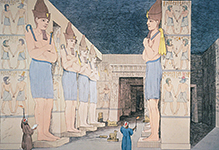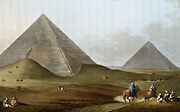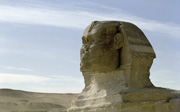
Egypt
Birth and Death,Cult and Gods,Pharaos and Officials,Pyramids and Temples,Daily Life.

#03010235
Reverse side of the throne of Pharaoh Tutankhamun (1346-1337 BCE) with four gold...

#03010236
Djed-pillar amulet (an enigmatic hieroglyph and amulet linked to Osiris' backbon...

#03010237
Egyptian pendants. Gold and precious stones (carnelian, turquoise and amethyst)...

#03010238
Gold vase with corn-shaped decorations and engraved with lotus and flowers. Za...

#03010239
Head of a falcon. This is a votive object belonging to a gold statue of the fal...

#03010240
Gold bracelet belonging to Pharaoh Ramses II (1290-1224 BCE); New Kingdom (19th...

#03010241
Le musicien d'Amon Djedkhonsouiouefankh joue de la harpe devant le dieu Re-Horak...

#03010242
Servant wearing panther skin offering lotus to God Osiris (depicted with flail a...

#03010243
Book of the Dead: The papyrus of Hunefer. Above Hunefer kneeling before a table...

#03010244
Rhind Mathematical Papyrus. A number of documents have survived that allow us i...

#03010245
Pharaoh Ramses II (1290-1224 BCE) holding Nubian, Libyan and Syrian prisoners by...

#03010246
Book of the Dead: Papyrus of Heruben. (Book of the Dead - collection of funerar...

